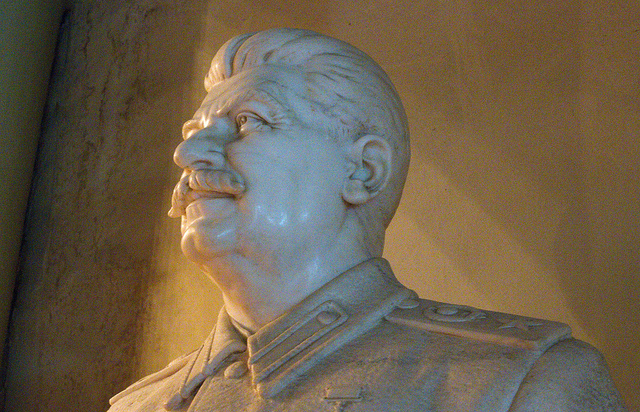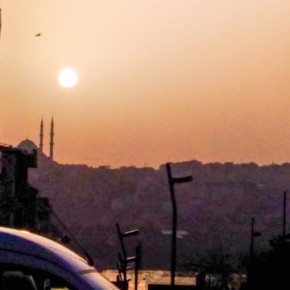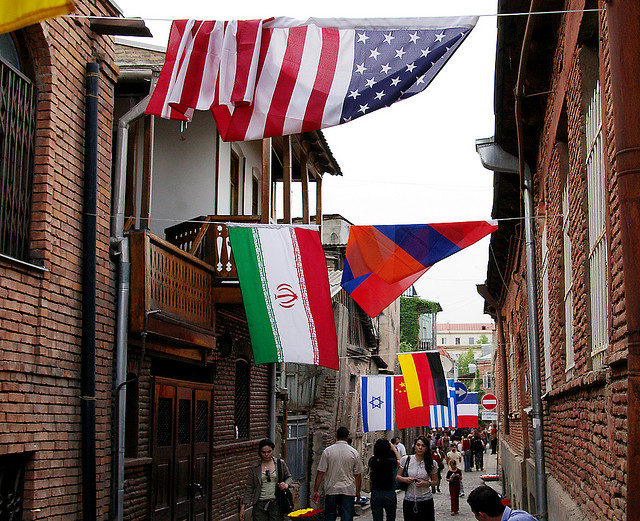Georgia’s blazing summers are occasionally interrupted by hailstorms which smash grapes from the vines and wreck the tomato farmers’ crops. It was while we were sheltering from one of these in the shop – the centre of village gossip – that I heard about the trouble in nearby Tsromi, a larger village in the same Shida Kartli region of central Georgia.
A new convent was being built, and opposite its entrance stood one of the last monuments to the country’s most famous son: Ioseb Jughashvili, aka Joseph Stalin. Uncomfortable with the idea of the great persecutor of the church greeting them every morning, the nuns wanted the statue taken down. Some locals however, were not happy; the statue had been paid for by public subscription, and they didn’t want their tribute to be so unceremoniously swept away.
Monuments to Stalin occupy an ambiguous position in Georgia, reflecting the people’s divided views of the man. The Americophile former president Mikheil Saakashvili described their presence as ‘barbarous’ and ‘unimaginable’ in a modern, western-looking nation, and set about their – sometimes clandestine – removal, often in the face of local opposition.
Since Saakashvili’s removal from power, the official stance has changed, and some statues have come back; in the eastern town of Telavi, the ‘Stalin Monument Erection Initiative’ backed with a long petition of support, organised the return of a 10ft silver Stalin (which was almost immediately vandalised). In Gori, the town of his birth, the local government granted $15,000 to bring back the huge Ozymandian statue removed in 2010 for ‘restoration’, but it is yet to reappear in the square that bears his name.

It is in this flat, fertile land between Gori and Tsromi that the Stalin controversy is most complex. On Stalin Avenue, in central Gori, the hovel where he spent his miserable childhood is preserved, encased in a neo-classical temple. Behind that, in the massive, unchanged Stalin Museum, his shaving kit, fountain pen and death mask are held in dusty grandeur. Tsromi, 25 miles away, has its own Stalin lore. It is said that he hid here while on the run from the Tsar’s police. He was sheltered, incongruously, by the priest inside the village’s fortress-like medieval church, from which he escaped via a tunnel, originally dug as a bolthole from marauding Tartars, into the wild hills beyond.
One elderly village woman told me her memories of Stalin’s death. A schoolgirl, she had stood with her classmates crowded around the staffroom door to hear the radio reporting the progress of his final illness. When the moment came, she says, the village was hung with black flags, and everywhere the women were dressed in mourning black. When her teacher came in to class that morning, she had tears on her face, and she couldn’t take the register, her voice cracking with emotion. Most of all, she remembers the palpable fear; the people’s fear of life without the great helmsman, without the man who, she still vehemently insists, saved the world from Fascism.
Her loyalty to Stalin is complicated. It is partially pride in a poor Gori boy who rose to inconceivable greatness. It is also nostalgia for a time of greater stability. While SUV- driving Gucci shoppers rumble through the streets of the capital, Tbilisi, many villagers have come through two decades of civil wars and economic collapse, only to feel cut out of the modest progress made in the Saakashvili years. Many of those who can remember the Soviet times feel that their quality of life has deteriorated sharply as healthcare and higher education, free under Communism, are now impossibly expensive for many of the nation’s impoverished farmers, while the rural infrastructure has been allowed to decay to the extent that many villages are pockmarked with the ruins of cafes, shops, cinemas and public halls which once served the community.
But probably most fundamentally, it is the continuing strength of Stalin’s cult of personality; these children of the 20s and 30s, who grew up with his face and word omnipresent and omnipotent, as he seemed to hold the very survival of the nation in his hands, were so powerfully inculcated that even now they see him as leader and saviour. It must be emphasised that many Georgians, particularly the young, are revolted by Stalin, but for many of those who grew up under him, he remains, in the words of one of the men who brought his statue back to Telavi, ‘our judge and our master, to whom every starving man prays’.
Photographs courtesy of Shay Haas and Soviet 15. Published under a Creative Commons license.





